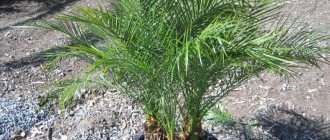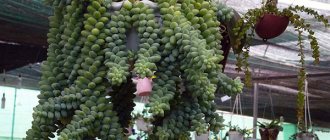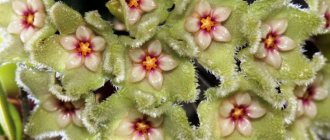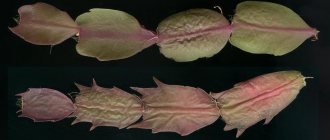Author: Elena N. https://floristics.info/ru/index.php?option=com_contact&view=contact&id=19 Category: Houseplants Published: January 18, 2019Last edits: January 11, 2021
- Why does the Decembrist wither
Decembrist is a cactus, but... “wrong.” Judge for yourself: there are no thorns, it loves humidity and does not tolerate direct sunlight, it refuses to bloom in drought... Experienced flower growers say that caring for a Christmas tree is more similar to caring for its exotic compatriot - the orchid, than for its prickly fellow cacti. In our latitudes, Schlumbergera blooms in winter, for which it received its “winter” names: Christmas tree, Decembrist. But with proper care, the Decembrist can bloom two or even three times a year.
- How to achieve such abundant flowering of the Christmas tree?
- Why does the Decembrist begin to fade?
- What to do if the leaves of the Decembrist fall off?
Our specialists know the answers to these and many other questions about caring for Schlumbergera.
Varieties of zygocactus
Since Decembrist is a relative of cacti, thanks to the painstaking work of breeders, there are a large number of subspecies, which differ from each other in the shape of the bud, their color, and the shape of the segments:
- Madame Butterfly;
- Orsichiana;
- Mix;
- Golden cream;
- Aspen;
- Buckley;
- Rousseliana;
- Gartner;
- Microfaerica;
- Prickly pear;
- Laverdendall;
- Christmas fantasy, etc.
There are ampelous types of Decembrist flowers, in which case they are grown in hanging flower pots or in special devices so that the leaves fall freely. A relative of Schlumbergera is Rhipsalidopsis (Easter). It differs in flowering time - April-May.
Types of the Decembrist
Most often, two specific types of Schlumbergera are called Decembrist. Truncated or chopped off - more compact, with light green shoots up to 40 cm. There are different shades of pink, purple and white. Schlumbergera Buckley or Bouclea is larger, up to 50 cm, and its shoots are darker. This is an ampelous look. Of the hybrid varieties, Lavender Doll, Windsor, Christmas Fantasy, Pasadena and Santa Cruz are especially interesting.
Photo: sueveriya.com
Hamedorea (50 photos): types, cultivation and care at home
Signs and superstitions
Beliefs and predictions are associated with the Decembrist, as with other indoor plants:
- if flowering begins on time, relationships with relatives will improve;
- if it started earlier, new interesting acquaintances will appear;
- if at an atypical time, there will be a new addition to the family.
Rozhdestvennik is a donor who gives residents well-being, peace, and vitality.
Lighting
The Decembrist plant loves a bright place, but without direct burning rays. This means that it can be installed on all sides of the world except the north. To prevent the sun's rays from falling on the delicate leaves, shade them with something.
In summer, it is useful to take it out onto the balcony or loggia. Do not forget to rotate the pot around its axis to avoid one-sided distribution of the green mass.
In winter, it is advisable to use additional lighting with a fluorescent or LED lamp.
Secrets of lush flowering
The secrets are simple, but it’s worth learning the intricacies of caring for a flower. Then photos of exotic Decembrist flowers will delight your loved ones.
Watering
How to properly water a Decembrist flower? It needs abundant watering when buds set and flowering occurs (November-January), but such that moisture does not pour out through the drainage holes.
With such waterlogging, not only will the roots begin to rot, but also the microelements necessary for the formation of color will be washed out. During the rest of the period, water once a week, in the summer 2-3 times so that the soil surface has time to dry.
Many amateur gardeners use soil moistening through a tray; in this case, the soil does not lose its structure, microelements are not washed out when overwatered, the roots do not rot and absorb as much moisture as they need. The water should be either rainwater or centralized settled water.
Planting, cultivation and care
To achieve beautiful flowering and grow a healthy plant, you need to know how to care for Decembrist at home. Contrary to its name, it can bloom not only in December. If you take good care of it, it will bloom more than once a year.
Watering
Caring for the Decembrist at home should ensure an optimal watering regime. In order for the Christmas cactus to have beautiful flowers, you need to give the plant a three-month rest from August to October. It is worth moving it to a cool room and reducing watering. Decembrist grown at home should not be fed or watered at ambient temperatures below 13 degrees.
In November, the cactus can be returned to its permanent place. Then watering and fertilizing are resumed to stimulate bud formation.
Attention! It is necessary to spray the leaves of Decembrist, especially in winter, when the temperature does not exceed 18 degrees. Zygocactus requires a humidity of at least 40%. The plant grows naturally in tropical forests, so it loves moist air. You only need to spray the shoots themselves; wet buds and flowers will fall off.
Decembrist needs to be watered regularly, preventing the soil from completely drying out or water from accumulating in the pot, which can cause root rot.
How to water Decembrist at different times
| Period of time | Irrigation rates |
| June – September | Water every 3-5 days with soft water. |
| At rest (August – October) | Watering the Decembrist is carried out once a week. |
| November – January | Watering should be a little more generous from the time the flower buds appear until they bloom. |
| February March | After flowering, zygocactus loses its characteristic shine on the shoots. This is a normal sign of going on vacation. During this period, plants should be watered minimally and only when the shoots begin to wrinkle. Water during rest only so that the soil in the pot does not dry out completely. |
| Until the end of May | After about 8 weeks of rest, you can begin to water the zygocactus sparingly. Until the end of May - water every 15 days. If new shoots appear at this time, they should be pruned. |
If the cactus is accidentally flooded with water, you need to dry the soil thoroughly. If the plant begins to rot and cannot be saved, you can make new plants from it by cutting the shoots into cuttings.
Fertilizer
They begin to feed Decembrist when the plant's dormant period ends or buds appear. During the growth period (winter, spring and the first half of summer), zygocactus should be fed 1-2 times a month with liquid fertilizers for cacti (succulents). It is recommended to add cow dung fertilizer directly to the soil. The best fertilizer should be rich in potassium and nitrogen, and contain iron, magnesium, copper, molybdenum, barium, and manganese.
From August until the first flower buds appear, you should stop fertilizing and reduce watering.
It is recommended to fertilize Decembrist every 2 weeks during the flowering period.
Something to remember! Too much nitrogen can inhibit flowering.
Reproduction
Decembrist is extremely easy to propagate. Every few years it is worth growing young specimens that are more compact, attractive, and bloom more profusely than older ones. This succulent is easily propagated by cuttings taken from shoots. To do this, it is enough to have one fairly old branched shoot. Reproduction is best done after flowering. The work order is as follows:
- Very delicately cut off a piece of the process, consisting of 2-3 members.
- The cuttings are dried for a day. Cut cuttings left for some time without water will not wither, since there is enough water reserves. The cuttings are planted in the ground only after scarring at the cut sites.
- The cuttings are placed in sandy (peat with sand) slightly moist soil and placed in the shade. The cuttings are placed deep enough in the ground so that the stem stands upright. You can cover the plant with film for quick rooting.
- Water and prevent the soil from drying out.
Rooting usually lasts 3-6 weeks.
The second method is to germinate cuttings in water.
To do this, the following work is carried out:
- Trim a shoot with at least three members.
- Place the shoot in water for 2-3 weeks.
- After this time, roots should appear.
- Prepare a pot suitable for the size of the seedlings.
- Expanded clay, stones or a broken clay pot are placed at the bottom. This will prevent stagnation of water at the bottom of the pot, which the zygocactus cannot tolerate. Then add some soil and plant the plant. Gently press down the soil around the seedlings so that they do not fall, and water them.
The young plant should bloom in a few months.
Photo. Sometimes the Decembrist himself gives roots.
The second method gives a 99% guarantee that the plant will be well accepted. With the first method, sometimes seedlings can rot.
You cannot feed a plant that is too young. Fertilizer feeding begins only a few months after planting.
Transfer
The Decembrist flower does not cause trouble and does not require frequent replanting. Zygocactus should be replanted in March - May, preferably every 3-4 years, into fresh, well-drained cactus soil. This could be as simple as replacing the soil in the same pot.
Pests and diseases
- When the air becomes too dry in winter, the plant may be attacked by mealybugs or felt mites. These pests produce a felt-like substance that protects them from environmental damage and insecticides. Felt beetles live in colonies, on less accessible parts of the plant, for example, in the axils of leaves. They are very tenacious, and many sprays have no effect on them, especially on young specimens. You can remove pests with a brush dipped in water and laundry soap.
- The plant can be attacked by aphids, less commonly by spider mites and scale insects. Special insecticides are used to control insects. It is also recommended to change the soil.
- The cause of many zygocactus diseases is excess water. In a wet and cold state, zygocactus can suffer from root rot. The symptom of rot is a black border at the base of the shoot caused by fungi. When damage to the roots is visible, the affected areas are removed. It is also advisable to replant the plant in fresh soil. Watering is limited until wounds heal. You can also use antifungal drugs with added zinc and copper.
- If the position is too sunny, the shoots may turn pinkish-red and burn.
- The buds may fall off due to a sudden change in position.
Photo. The Decembrist leaf withered as a result of being attacked by spider mites.
Why doesn't the Decembrist bloom?
The Christmas cactus blooms from December until late winter. However, for it to bloom, a number of conditions must be met:
- A Christmas boy should rest twice a year. The first holiday falls at the turn of February and March, and the second lasts from August to October.
- From August to October, the plant should be moved to a cool place with a temperature of 8-10 ºC.
- The home Decembrist will give flowers provided there is at least 10 hours of complete darkness per day for 3 months (August-October), that is, until flowering. Even the light of a light bulb affects the extension of daylight hours for a plant. Even diffused light from another room extends daylight hours.
- Poor lighting during the day also makes it difficult to set flowers. The flower does not tolerate too much sun. Sometimes flower growers wonder why the leaves of the Decembrist turned red or turned purple. Direct midday sunlight burns the plant, the leaves wither, fall off, and turn purple. The plant needs 2-4 hours of intense sunlight per day, preferably in the evening or early morning.
- Poor watering. This tropical plant does not like drought. The soil in the pot should not dry out completely.
- The air temperature is too high (above 20 ºC) and the position is too shady.
- Excessive nitrogen fertilization.
- A pot that is too large contains a lot of soil, which absorbs a lot of water. The Decembrist has a small root system and does not use all the moisture, as a result, rotting and falling off of flower buds can occur; a blooming Decembrist can drop its flowers. The plant should be grown in small pots.
- Unstable conditions. Too rapid changes in growing conditions - temperature changes, changes in humidity, decrease or increase in light intensity, drafts lead to the dropping of flowers and buds.
Decembrist itself is not a very ornamental plant, but when it blooms, it amazes with its appearance. The plant is showered with white, pink, purple, red, salmon and yellow flowers, growing singly or in pairs. Growing and caring for this plant does not cause problems, but abundant flowering requires certain treatments. It is worth knowing how to properly grow Decembrist so that it pleases you with its beauty.
Temperature
Since zygocactus comes from the tropics, it loves air humidity and tolerates high temperatures. Therefore, tolerance ranges from 2°C to 40°C. It is unlikely that there will be such temperature changes in room mode.
The optimal temperature in winter and spring is 12-16°C, in summer – 18-26°C, during flowering 16-18°C. By showering, the leaves will not only be saturated with moisture, but the dust will also be washed away, and in the summer it will help to cool down. This procedure cannot be carried out only during flowering.
Diseases and pests
The flower is immune to most pests and diseases, unless, of course, it is healthy. But against the background of excess or deficiency of watering, as well as in the case of proximity to diseased plants, the Decembrist’s immunity decreases.
Preparations that will help in pest control:
- spider mites - “Fitoverm”, “Vertimek”, “Aktofit”;
- mealybug - “Aktara”, “Konfidor”;
- scale insects - insecticides.
The soil
The soil can be purchased either at a flower shop - soil for succulents (plants with fleshy stems), or you can make it yourself: mix equal parts compost, turf soil, sand, add vermiculite and ash.
Growing conditions
Decembrist grows and blooms better in light soil, for example, sandy (peat mixed with sand) and in cool apartments where the air is not too dry.
Requirements for planting site and soil
Decembrist should grow in a well-lit, sunny place, but not in direct sunlight. In summer it can be placed on a shady balcony, from where it should be brought into the room in September. Schlumbergera loves bright, warm places, preferably on a window. In summer, the window needs to be slightly shaded; it is better to choose a northern exposure. If the cactus is located on a window with a lot of sunlight, it must be screened, preferably with a curtain or thin blinds that diffuse the light. You can also move the plant to the west window.
In the summer, Decembrist likes to be exposed to fresh air outside the apartment, but in an area not exposed to direct sunlight, which can burn and dry out the plants.
The Christmas cactus should not be moved, especially while it is blooming! He can drop all the flowers.
Soil requirements
Zygocactus should grow in humus soil combined with coarse sand.
The best soil for Decembrist includes the following components:
- compost soil (3 parts);
- leaves (2 parts);
- sand (1 part).
Some textbooks recommend using orchid soil mixed in equal parts with compost. The mixture must be permeable, the pot needs drainage.
After planting, the plant should be watered moderately, increasing the amount of water only when new shoots appear. Then you can apply fertilizing.
Requirements for air temperature, lighting
- Decembrist blooms at temperatures up to 20 degrees Celsius and in the shade.
- Zygocactus is a short-day plant. You can adjust the flowering period throughout the year by extending it with artificial lighting.
- The best temperature for flowering is 15-16 degrees Celsius.
- Flowering will not begin if the plant is moved to another location during budding.
- The Christmas cactus does not like frequent changes of place and even rotation during flowering and rest.
- The plant is sensitive to sudden temperature changes, excessive watering, and drought.
- In summer, the plant should be kept at normal room temperature of about 20-22 °C.
Top dressing
Buy fertilizer for a given crop; if you don’t have one, then it will work for ordinary flowers, only in liquid form. In this case, feed not as written in the instructions, but diluted twice.
Feed in the spring - once a month, in the summer, during the formation of leaves - twice a month, in the fall, during preparation for budding - stop feeding. Instead, it is better to spray with some fungicide to prevent the formation of fungal diseases.
Following all the recommendations correctly:
- in the fall, stop frequent watering and fertilizing;
- three months before flowering, place in a cool, shaded place;
- in December, place in a well-lit place and start watering abundantly,
The Christmas lover should feel the signal and give color just in time for the “New Year”.
Hybrids of zygocactus with variegated colors
Selection does not stand still and scientists are interested in obtaining hybrids and varieties not only with varied colors of inflorescences, but also leaves. Plants with light spots on the leaves are called variegated.
Kristen Aurea Variegata
Traffic light plant! The segments are colored green, yellow and red. The flowers are white and pink.
Variegated with white flowers
Variety from Australia. Pure white flowers against a background of variegated shoots. The main background is green with yellow splashes.
Madame Butterfly variegata
Hybrid from the Madame Butterfly variety. The variegation is strongly expressed and manifests itself in a marbled creamy-yellow color throughout the shoot.
White Bell Variegated
The shoot segments are dark green, with large white and yellowish spots at the joints. The flowers are pure white with a pink pistil hanging down.
Reproduction
Schlumbergera is propagated in two ways - cuttings and seeds.
Propagation by cuttings
The preferred time for reproduction is spring and summer. The method of propagation by cuttings is very simple and unpretentious.
You just need to unscrew a leaf with two or three segments from the main plant, deepen it into moist soil, cover it with film, make holes in it for ventilation and place it in a warm, bright place. To accelerate the formation of roots, you can use rootin or zircon.
As soon as a new segment begins to appear, the cuttings have taken root and are ready to be transplanted into a pot. You can propagate the plant differently by placing the cuttings in a glass of water and waiting for the roots to appear before transplanting them to a permanent place of growth.
Propagation by seeds
In the wild, Schlumbergera flowers are pollinated by insects, after which an ovary is formed and a pink, pear-shaped fruit about two centimeters in length grows. This edible berry stays on the segment until the next flowering, gradually ripening. It tastes sour, birds eat it, and spread the seeds around with excrement.
No matter how good the care is, you cannot get seeds in indoor conditions. Therefore, purchased seeds are used. Having planted them in moist soil and covered them with a film with holes for ventilation, wait for them to sprout. The period varies from 20 days to several months. When shoots appear, wait until they get stronger, and then transplant them into pots.
What happens to the plant after 15 years
With age, the Decembrist does not look as attractive as it does when the plant is still young. The trunk at the base takes on an ugly curved appearance, the branches of the plant become like a cork. It is necessary to make some efforts to ensure that the Decembrist always looks well-groomed. The homeland of the plant in one way or another affects the life cycle of the flower. Plants that are too old should be replaced with new ones. The breeding season is most successful in the spring, with the preferred months being April or May. To do this, you need to cut several cuttings and place them in damp sand or soil. For new seedlings, choose spacious but shallow pots, at the bottom of which you should definitely lay a layer of drainage in order to prevent rotting of the root system.
Disease Control
If the leaves have lost their healthy shine, become pale, lost their elasticity, and segments have begun to fall off, this means the plant is sick.
- Fungal diseases such as phytium, fusarium, late blight could provoke these symptoms. These diseases are treated with fungicides. It is necessary to transplant the flower into healthy soil, having previously treated the roots with a disinfectant (for example, a solution of potassium permanganate).
- Overdried roots could also provoke this series of symptoms.
- The plant could have suffered stress - a large temperature difference, a draft, or moving from a store to a home.
- Overfeeding or lack of microelements.
- Overwatering.
If the Decembrist is provided with proper care, then every “New Year” he will give the owners a bouquet of Christmas flowers.
How to choose a Decembrist when purchasing
When buying Decembrist in a store, you should pay attention to the appearance of the flower, as well as the quality of the soil in which it grows. The substrate should be slightly moist, and the indoor plant itself should not show signs of rot.
Despite the fact that the flowering plant looks much more beautiful, it is worth choosing a specimen, the bulk of the flowers of which are not fully revealed. The fact is that, once in home conditions, the Christmas tree sheds the bulk of its flowers. This is completely normal, so don't be upset.
It is not advisable to replant immediately after purchase. However, if the procedure cannot be postponed, you should carefully transfer the plant into a larger pot. The earthen lump cannot be disturbed in this case.
By providing proper care for the Decembrist, you can create ideal conditions for the growth and development of the plant. With its lush green foliage and vibrant, long-lasting blooms, this indoor plant will be a real addition to any room during the cold winter months.











